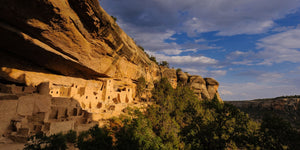3 Steps to Avoid Mesa Verde Altitude Sickness

On a weekend long trip to Mesa Verde National Park you might experience altitude sickness. This is something that many travelers have to deal with when traveling to the Rocky Mountains of Colorado or the southwest area where Mesa Verde is located. This post will help you to prepare for the trip and avoid Mesa Verde altitude sickness.
Mesa Verde Altitude Sickness
Mesa Verde National Park is a special place. It is among the most popular attractions in Colorado and is a true national treasure. It's not just the only national park in the country devoted to preserving the homes of ancient Native Americans, it is also one of the most otherworldly places in the West. Located in Southwestern Colorado, the park is home to numerous archaeological sites, including the famous Cliff Palace – one of the largest and best-preserved cliff dwellings in North America.
The landscape is lunar-like with its red rocks and ancient dwellings carved into alcoves in the side of cliffs. The dry air and elevation can be challenging for visitors who are not accustomed to spending time at high altitude.
Mesa Verde National Park sits between 7,000 and 8,500 feet above sea level. If you are coming from the east coast or elsewhere at sea level, the altitude change can take a toll on your body. In fact, as many as 25% of people visiting Mesa Verde can experience some degree of altitude sickness.
Altitude sickness occurs when you travel to a higher elevation with significantly lower oxygen levels. Altitude sickness can affect anyone, even if you are in good shape. The symptoms of altitude sickness are:
- headache
- nausea
- dizziness
- shortness of breath
- nausea
- fatigue
Many people can feel some lightheadedness on the first day in Mesa Verde National Park. Visitors could experience minor symptoms such as shortness of breath, rapid pulse rate and fatigue for the first day or so. It's best to have an altitude sickness prevention plan in place before you visit.
3 Steps to Avoid Mesa Verde Altitude Sickness
Mesa Verde National Park is known for its incredible cliff dwellings, but the park’s high elevation means that visitors could experience altitude sickness. Thankfully there's some steps you can take to avoid Mesa Verde altitude sickness.
If you are planning a trip, here are three steps for avoiding Mesa Verde altitude sickness:
1. Take it easy upon arrival.
It is important to give your body time to adjust and acclimate to the new elevation levels in Mesa Verde National Park. Though you may be eager to explore after arriving in Cortez or Mancos, CO, be sure to take it easy during the first day or two in the area so your body can get used to being at a higher elevation than normal.
Also use caution when hiking. Avoid hiking on steep trails right away, especially if you've just arrived at Mesa Verde that day. Instead, take it slow and enjoy some of the easier hikes or trails, like Spruce Tree House or Petroglyph Point. Once you've had a chance to acclimate to the elevation, then you can attempt some of the more strenuous hikes.
Taking it easy and a good nights sleep will help your body better fight off the potential Mesa Verde altitude sickness.
2. Stay hydrated.
Go too long without drinking water, and you can experience altitude sickness, which can include dizziness, headaches and fatigue. Staying hydrated is key when it comes to avoiding altitude sickness in Mesa Verde National Park because dehydration can actually cause or worsen symptoms of altitude sickness.
The dry air and low press elevation of Mesa Verde can deplete your body's supply of fluid and salt. Drink plenty of water during your visit and avoid alcohol until you're acclimated. Common advice is drink at least half your weight in ounces of water.
To boost your hydration levels, add Zaca's
hydration packets for increased water and electrolyte intake.
3. Take An Altitude Adjustment Supplement
To avoid altitude sickness, take an
altitude adjustment supplement like
Zaca before you arrive. In our research, we found two science-backed natural ingredients to help avoid altitude sickness. These two ingredients are:
-
Glutathione - Glutathione is known as one of the most powerful antioxidants in the human body and key to fighting oxidative stress caused by high altitudes. Science shows that Glutathione depletes rapidly from high altitude conditions, so supplementing this key amino acid helps reverse and store the damage.¹
-
Dihydromyricetin - Dihydromyricetin (DHM) is an extract from the Hovenia Dulcis tree that has been shown to improve physical performance at high altitudes.² This makes dihydromyricetin very useful for athletes or travelers who are trying to reach high altitude areas such as Mesa Verde.

Brand new and scientifically developed, Zaca chewables helps your body rehydrate, replenish and recover at high altitudes. While containing both science-backed Glutathione and Dihydromyricetin, Zaca has no caffeine or harmful stimulants, so you can experience great benefits without any of the discomforts. Taking the chewables provides much-needed hydration and fuels your body with a zen-like strength nutrition.
Make your travels much easier and try Zaca's chewable tablets today!
SOURCES:
1. Effect of high altitude (7,620 m) exposure on glutathione
https://pubmed.ncbi.nlm.nih.gov/11320641/
2. Dihydromyricetin Improves Physical Performance under Simulated High Altitude
https://journals.lww.com/acsm-msse/fulltext/2014/11000/Dihydromyricetin_Improves_Physical_Performance.6.aspx

